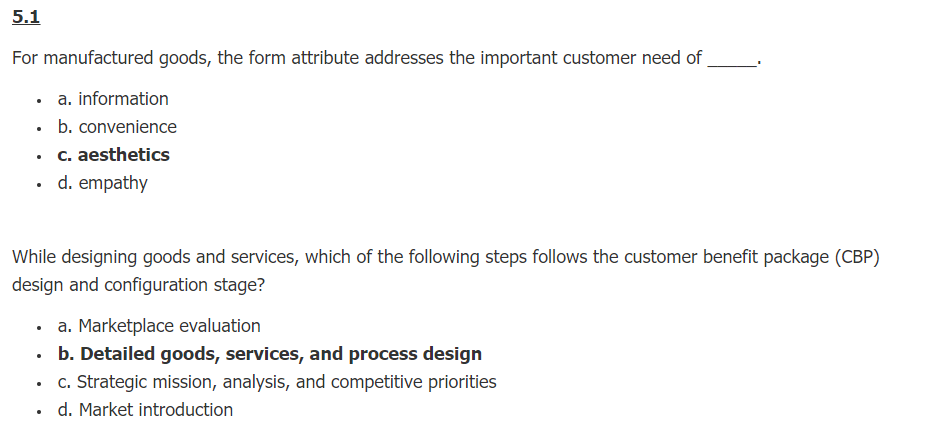(Solved): BUS 384 : Concept Check 5.1, 5.2, 5.3, 5.4 and 5.5 ...
BUS384: Concept Check 5.1 , 5.2 , 5.3 , 5.4 , 5.5
Submitted 28 May
5.1
For manufactured goods, the form attribute addresses the important customer need of _____.
- a. information
- b. convenience
- c. aesthetics
- d. empathy
While designing goods and services, which of the following steps follows the customer benefit package (CBP) design and configuration stage?
- a. Marketplace evaluation
- b. Detailed goods, services, and process design
- c. Strategic mission, analysis, and competitive priorities
- d. Market introduction
From which of the following perspectives must service design be addressed?
- a. The service-recovery system
- b. The benefit package configuration
- c. The market evaluation
- d. The service encounter
The process of building prototypes within a short period of time to reduce product development cost and time to market is known as _____.
- a. mass prototyping
- b. packaged prototyping
- c. rapid prototyping
- d. virtual prototyping
5.2
The _____ must translate the voice of the customer into specific technical features that provide the "blueprint" for manufacturing or service delivery.
- a. execution process
- b. design process
- c. market deployment process
- d. prototype testing process
_____ is an approach to guide the design, creation, and marketing of goods and services by integrating the voice of the customer into all decisions.
- a. Market deployment
- b. Quality function deployment
- c. Business analytics
- d. Service-encounter design
The quality function deployment (QFD) process is initiated with a matrix called the _____.
- a. voice of the customer
- b. House of Quality
- c. value chain
- d. service process design
5.3
In the context of designing manufactured goods, the _____ assumes that any value within the tolerance range is acceptable, but those outside are not.
- a. goal-post model
- b. House of Quality
- c. quality function deployment model
- d. Taguchi loss function
_____ is defined as the probability that a manufactured good, piece of equipment, or system performs its intended function for a stated period of time under specified operating conditions.
- a. Quality function deployment
- b. Reliability
- c. Sustainability
- d. Service guarantee
_____ is defined as the process of designing a product for efficient production at the highest level of quality.
- a. Design for manufacturability
- b. Design for reliability
- c. Design for Environment
- d. Design for sustainability
Which of the following is true of electrical equipment designed for sustainability?
- a. They are designed into a servicescape to please the five human senses.
- b. They are intended to function for a stated period of time under specified operating conditions.
- c. They decrease the carbon dioxide release in the environment.
- d. They are designed to reduce complexity during manufacturing.
The products designed for sustainability:
- a. cannot be easily repaired.
- b. release more carbon dioxide.
- c. cannot be disassembled.
- d. are designed for refurbishing.
5.4
In the context of the service-delivery system design, which of the following establishments depends on good location decisions?
- a. An assembly line
- b. A chocolate factory
- c. An airline head office
- d. A bank branch
YourCafe, a popular café in the United States, is planning to increase its market share and has decided to open its outlets in all major airports and shopping malls across the country. Which of the following elements of service-delivery system design is YourCafe trying to address?
- a. Service process and job design
- b. Facility location and layout
- c. The servicescape
- d. Technology and information support systems
Which of the following principal dimensions of the servicescape is designed to please the five human senses?
- a. Spatial layouts
- b. Ambient conditions
- c. Information support systems
- d. Signs, symbols, and artifacts
In the context of the servicescape, spatial layout and functionality refer to:
- a. ambient conditions, color, and aroma in a place.
- b. the arrangement of mission statements and diplomas on a wall.
- c. explicit signals that communicate an image about a firm.
- d. how furniture, equipment, and office spaces are arranged.
The management of GoodMarket, a popular retail chain, has decided to expand to incorporate an enclosed and monitored play area for kids. The idea behind this decision is that keeping the kids busy in the play area will enable the customers to shop for longer periods. Which of the following dimensions of servicescape is the management of GoodMarket addressing?
- a. Ambient conditions
- b. Spatial layout and functionality
- c. Signs, symbols, and artifacts
- d. Customer benefit package
Which of the following is an example of an elaborate servicescape?
- a. An online ticket outlet
- b. A kiosk
- c. An airport
- d. An automatic teller machine
_____ is the activity of developing an efficient sequence of activities to satisfy both internal and external customer requirements.
- a. Process recovery
- b. Business analytics
- c. Customer benefit package design
- d. Service process design
5.5
_____ refers to the physical or virtual presence of the customer in the service-delivery system during a service experience.
- a. Customer contact
- b. Customer loyalty
- c. Customer benefit package design
- d. Customer empowerment
Service-delivery systems with high customer contact:
- a. are difficult to design.
- b. operate at higher level of efficiency.
- c. should be treated like an assembly line.
- d. are easy to control.
_____ means giving people authority to make decisions based on what they feel is right, to have control over their work, to take risks and learn from mistakes, and to promote change.
- a. Service guarantee
- b. Assurance
- c. Empowerment
- d. Flexibility
In the context of service-encounter design, empowered employees:
- a. require a consistent understanding of what actions they may or should take.
- b. seldom take any risks during the service encounter.
- c. need to follow the directions and stick to the organization's standard operating procedures.
- d. usually fail to promote any change in service level.
Samuel runs a small restaurant with limited parking space for employees. Every month he assigns a parking spot to the employee who generates maximum sale in the previous month. In the context of service-encounter design, this is a form of _____.
- a. empowerment
- b. recognition
- c. authorization
- d. entitlement
Mandy owns a cosmetics store. When one of her employees, Misha, effectively deals with a service upset and manages to make a huge sale, Mandy awards her with a paid holiday. In the context of service-encounter design, this is a form of:
- a. entitlement.
- b. authorization .
- c. recognition.
- d. empowerment.
Which of the following is defined as a promise to reward and compensate a customer if a service upset occurs during the service experience?
- a. A service recovery
- b. A service guarantee
- c. Empowerment
- d. Reliability
Expert Answer

Buy This Answer $15
-- OR --
Subscribe $20 / Month
